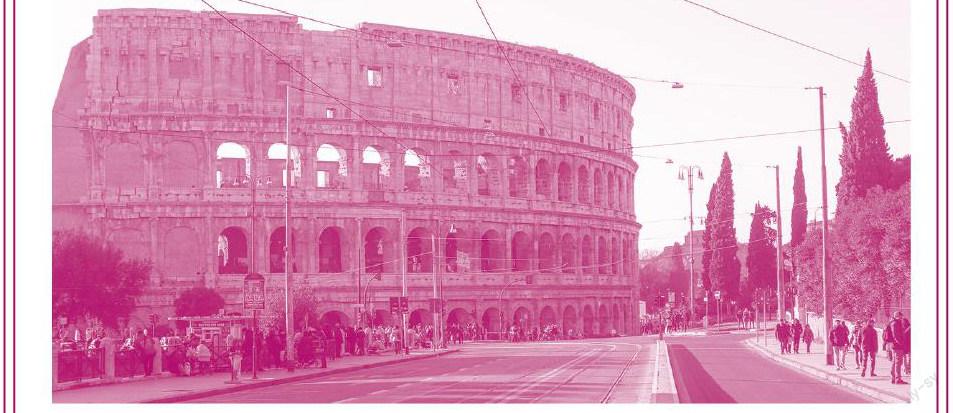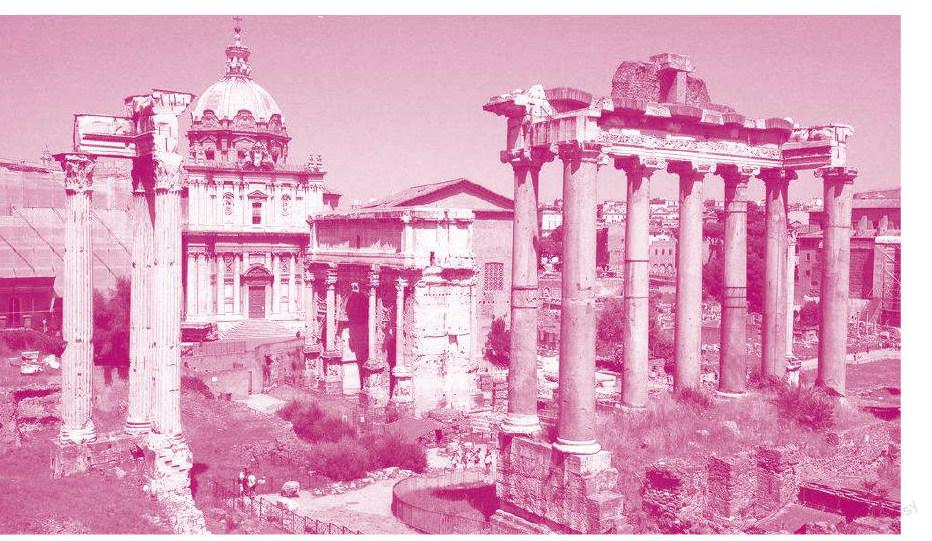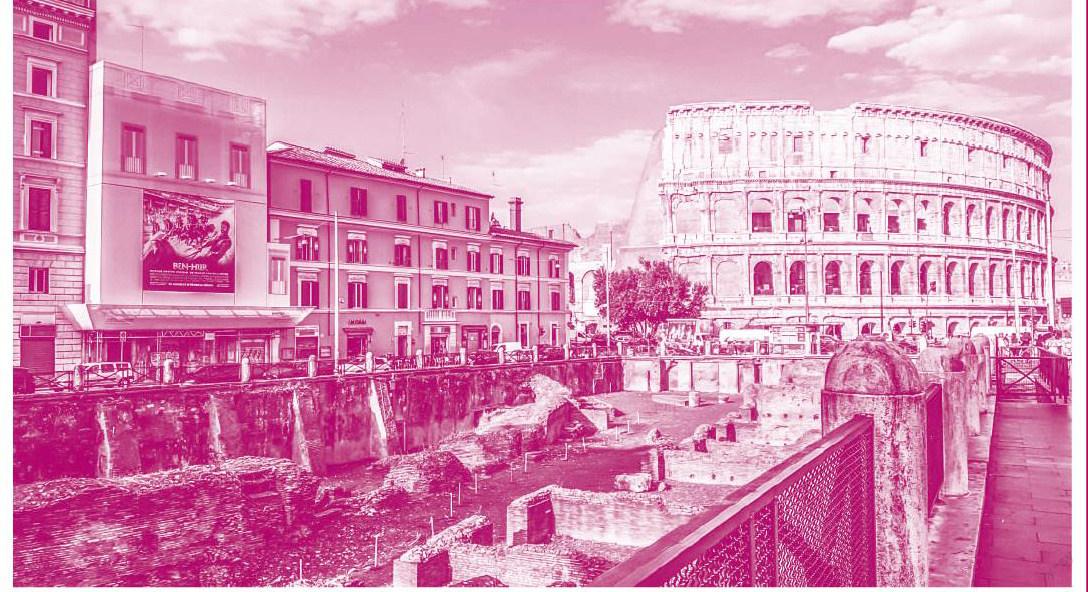Rome Was Not Built in a Day (Ⅰ)罗马不是一天建成的(上)
2022-05-30ByV.M.Hillyer
By V. M. Hillyer



By V. M. Hillyer
——V. M. 希利尔(仲秋 译)
V. M.希利尔(1875—1931),美國著名儿童教育家、科普作家,创建了卡尔弗特教育体系。他为孩子们编写了一套趣味盎然的历史、地理、艺术读物,即《写给孩子看的世界历史》《写给孩子看的世界地理》《写给孩子看的艺术史》。本文选自《写给孩子看的艺术史》,该书写于二十世纪二三十年代。
Some people wear imitation pearls, imitation diamonds, imitation jewelry—just for show. Some people build houses of concrete blocks to imitate stone, paint wooden columns to imitate marble, cover plaster walls with paper to imitate tile. Such imitations that pretend to be something they are not, are a kind of cheating, a fake. The Greeks never faked in this way. The Romans did so often. They built buildings of concrete or brick and covered the outside with thin pieces of marble.
For a few hundred years before and after Christ was born, the Romans built and built, many and great buildings, and more buildings of more kinds than had ever been built before. They built them not only in Rome and in Italy, but in other countries which the Romans owned.
有一些人喜欢戴仿造的珍珠或者钻石首饰,或许仅仅是为了炫耀。有一些人修建房子时喜欢用混凝土仿造石头,或者用漆刷过的木柱仿造成大理石柱子,还有人在石灰墙上贴了墙纸仿造成瓷砖的样子。这类仿造成其他东西样子的做法,是欺骗,是造假。古希腊人从来不会采用这种做法,但是罗马人却十分喜欢。罗马人在盖房子的时候使用混凝土或者砖头,最后在外墙贴一层薄薄的大理石板——看起来就像是大理石盖的房子一样。
在公元元年前后的几百年时间里,罗马人不停地建造房屋和各种建筑,他们修建了许多非常雄伟的建筑,建筑的种类更加丰富,超过以往任何时候修建的建筑。他们不仅把建筑修建在罗马和意大利地区,还修建到了由罗马控制的其他国家。
Though the Romans built many great buildings, none of them quite equaled those the Greeks built. The reason was that the Romans were not artists but engineers. The Greeks were very religious and built temples; the Romans were great governors and worshiped everything that concerned governing. The Romans used instruments to design their buildings, whereas the Greeks used their eyes. In a Roman building, every line that was supposed to be vertical was vertical. Every line that was supposed to be horizontal was horizontal. Every line that was supposed to be straight was straight. It was as if they had drawn a picture with a ruler and square and compass instead of free-hand.
In the same way, a Roman building looks mechanical. We like them as we like an engine. They are strong and powerful, but somehow seem to lack the beauty of a hand-made picture.
How many kinds of buildings do you think there are in the place where you live? Try to count them. Houses, of course, but how many others—churches, banks, stores, court-houses, libraries, and so on.
尽管罗马人修建了很多很多的房子,但没有一栋能与古希腊的建筑相媲美。这是因为,罗马人只是建筑工程师,而不是艺术家。古希腊人信奉宗教,所以他们修建了大量的庙宇。罗马人却是出色的统治者,因此他们对所有与统治有关的事物都十分崇尚。古希腊人用自己的眼睛设计建筑,而罗马人设计房子用的是测量工具。罗马建筑中所有需要垂直的线条都是完全垂直的,所有需要水平的线条则都是完全水平的,所有笔直的线条就都是笔直的。这些建筑看起来都不像是人工建出来的,反倒像是用直尺和圆规画出来的,绝对规整的一幅图画。
也正是因为这样,罗马的建筑看上去非常机械、呆板。我们喜欢罗马人的建筑,就像是对发动机的喜欢之情。因为尽管他们都非常强壮有力,但是总还是缺少一种手绘图画的人文之美。
你家附近不同的建筑有多少种呢?试着数数吧!当然了,住宅肯定会有很多,但其他种类的建筑有多少呢,比如说:教堂、银行、商店、法院、图书馆,等等。
Word Study
imitation /'?m?'te??n/ n. 仿制品;赝品
Its not real leather; its only an imitation.
marble /'mɑ?bl/ n. 大理石
fake /fe?k/ n. 假货;赝品
worship /'w????p/ v. 崇敬,崇拜(上帝或神)
horizontal /'h?r?'z?ntl/ adj. 水平的;与地面平行的;横的
mechanical /m?'k?n?kl/ adj. 机械般的;呆头呆脑的
He looks very mechanical.
The Greeks had only a few, but the Romans built many kinds—not only temples, houses and palaces—
Arches and aqueducts
Bridges and baths
Court-houses and halls
Theaters and amphitheater
Some were fake, but not all, and some were magnificent and imposing. Most of the Roman buildings are now in ruins, but one building—a temple built to all the gods—is still standing and in use today. It is called the Pantheon, which means “All the Gods.” It has a porch in front with Corinthian columns, and back of the porch a circular building with a huge dome made like a bowl turned upside down, of concrete. The circular walls that support the dome are twenty feet thick and the only window is a large circular opening in the top of the dome. There is no glass in the opening, but so high is it above the floor that even a heavy rain barely wets the floor beneath.
古希腊人的建筑没有多少种,但罗马人建造了大量不同种类的建筑,他们不仅仅建了庙宇、住房、宫殿,还修建了拱门和引水渠、桥梁和浴室、法院和市政大厅、剧院和竞技场。
这些建筑中有一部分是仿造的,但也并非全都如此,而且其中有些建筑建造得非常雄伟壮观。到了今天,大部分的罗马建筑只剩下了断壁残垣,不过还是有一幢建筑——是给众神修建的庙宇——却完好地保存着,这座建筑叫作“万神殿”。万神殿的正面有一排科林斯式柱组成的柱廊,柱廊的后面连接着一栋巨大的环形建筑。这个环形建筑的顶部是一个巨大的圆屋顶,就像一个混凝土的大碗被翻扣过来一样。而支撑圆顶屋的环形墙壁差不多有6米厚。在这个建筑中,唯一的窗户开在圆屋顶的顶部,是一个圆形的窗口。窗口没有玻璃,但因为它设计得非常高,離地面也就很远,所以即使下着倾盆大雨,屋里的地面也几乎不会被淋湿。
The Square House is one of the finest of these Roman buildings, with engaged Corinthian columns as well as with whole columns.
It is not in Rome, however. It is in what is now France, but when it was built, France was a part of the Roman Empire and Romans built it. In France they call it the Maison Carrée, which means Square House.
The theaters where the Roman actors gave plays had no roofs. The seats were of stone and were arranged in a half circle that sloped upward as today. In France, at a town called Orange, is a Roman theater in which plays are still given.
罗马人修建的房屋当中,方形神殿算得上是最好的建筑之一了。这主要是因为方形神殿运用了科林斯柱式的廊柱表现风格,当然也因为整体的廊柱都非常好。
不过方形神殿并不在罗马,而位于今天的法国。这是因为当时的法国还是罗马帝国的一部分,所以罗马人在那里修建了方形神殿。现在,法国人把这个方形神殿称为“方形房子”。
剧院是罗马演员演出的地方,它是露天的。剧院里的座位都是用石头直接砌成的,但也和我们今天的剧院一样,半圆形的看台呈阶梯状排列。在法国,有一个名叫橘郡的小镇,那里也有一个古罗马时期的剧院,到现在那里还一直举办着表演活动。
Word Study
imposing /?m'p??z??/ adj. 壮观的;使人印象深刻的
dome /d??m/ n. 穹顶;圆屋顶
barely /'be?li/ adv. 几乎不;几乎没有
There was barely any smell.
slope /sl??p/ v. 倾斜;有坡度
The garden slopes away towards the river.
